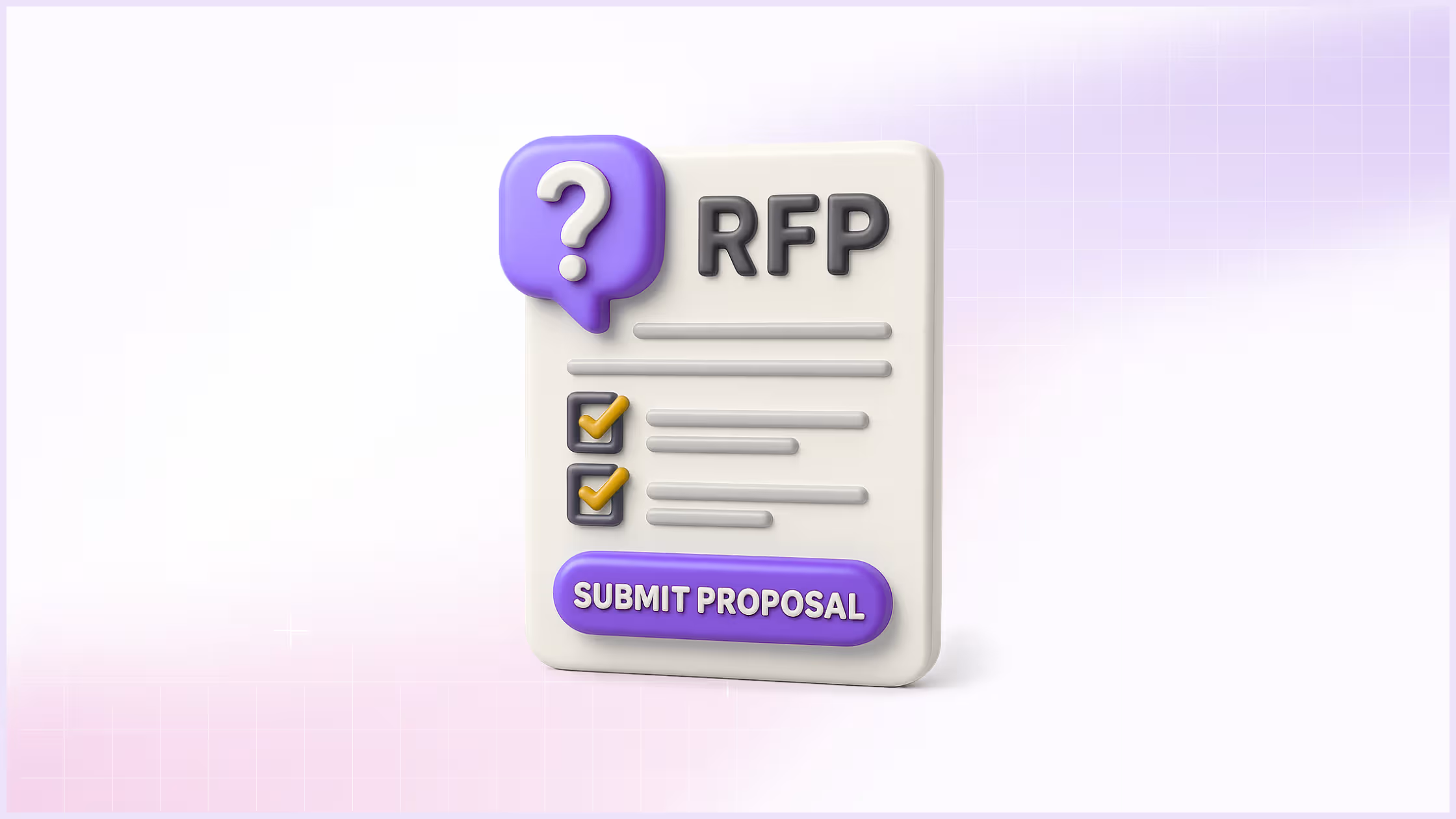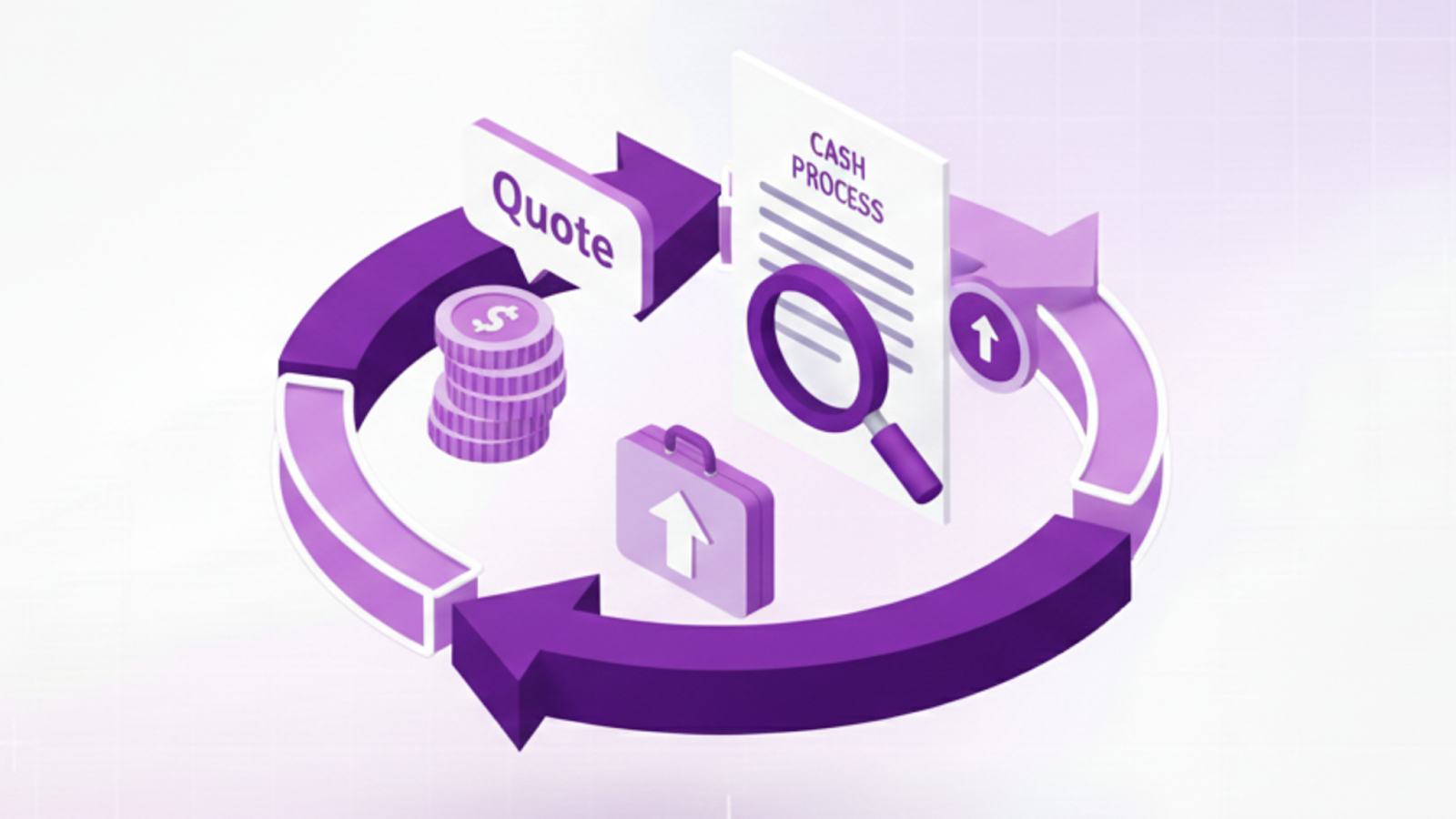Responding to a Request for Proposal (RFP) is one of the most strategic ways companies win new business, especially in competitive markets where differentiation, customization, and value make all the difference. Yet despite the high stakes, many teams still struggle with the basics: finding answers quickly, collaborating with the right people, and submitting a complete response that stands out.
Whether you’re dealing with a government procurement, a public sector RFP, or a private sector opportunity, the fundamentals remain the same. A well-structured approach to answering RFP questions can transform your proposal process from chaotic to efficient and ultimately help you win more deals.
In this guide, we’ll walk you through the steps to mastering the RFP questionnaire, answering vendor RFPs with confidence, and optimizing your proposals using smart techniques and RFP automation.
1. Start by understanding the RFP questionnaire
Before you start typing answers or pulling from an RFP questions and answers template, pause and digest the full document. Many vendor RFPs include complex requirements that touch on legal compliance, GDPR, privacy regulation, and handling of personal data or sensitive information. Misinterpreting even a single item can lead to non-compliance or outright disqualification.
Use this time to clarify ambiguous language, technical jargon, or conflicting instructions. Asking questions of the procurement team is a sign of professionalism. The right questions to ask before responding to an RFP might include:
- Are there any organizational protocols that must be followed in submissions?
- Is there a specific legal interpretation of this privacy clause?
- What are the expectations around the executive summary?
- Is there a preferred format for the complete response?
These vendor questions show you’re serious about alignment, legal compliance, and delivering the best value.
Taking the time to fully understand the RFP allows you to avoid rework, reduce delays, and create answers that are both concise and relevant. It also signals your attention to detail, which clients always appreciate. This early step lays the groundwork for a smoother process and more compelling content throughout your proposal.
2. Break down the RFP into manageable sections
Start by dissecting the vendor RFP into logical parts: technical requirements, legal compliance, pricing, value propositions, and supporting documentation. Assign each section to a domain expert or team member. Make sure someone reviews for enterprise question and answer formats, especially in highly regulated sectors.
RFP questions typically fall into a few main categories:
- Free-text responses, where you’re expected to deliver concise answers
- Multiple-choice questions (MCQs), such as: “You are responding to an RFP wherein a question MCQ asks about data retention policies. What is your approach?”
- Checklists or tables, common in the post RFP and audit phase
Having a system in place ensures nothing gets overlooked. An RFP automation tool can help map questions to existing content or a sample RFP questions library, reducing manual effort and increasing consistency.
When you break down the Request for Proposal into specific sections, it helps distribute the workload across your team, allows for more specialized contributions, and supports clearer accountability. It also helps identify gaps in your content library or knowledge base that need to be addressed before submission.
3. Collaborate with experts early and often
Many teams delay bringing in their subject matter experts (SMEs), legal experts, privacy officers, or supervisors until late in the process. This often results in rushed or incomplete responses, especially to RFI questions to ask vendors or highly technical vendor questions involving privacy laws, GDPR, and sensitive information.
Instead, brief your team early. Share an overview of the RFP, assign responsibilities, and give everyone clear timelines. Use your content library to find previously approved answers, especially on recurring topics like legal compliance, public sector policies, or data protection protocols. Even when customization is needed, it’s faster to tweak existing content than to start from scratch.
Your SMEs will thank you, and your proposals will benefit from stronger answers backed by solid evidence. Building strong relationships with these internal stakeholders ensures ongoing improvements in your proposal content. It also enables faster turnaround times when dealing with urgent or high-value bids.
Effective collaboration also reduces miscommunication. Using collaborative platforms or RFP automation software can further streamline reviews and feedback collection, ensuring everyone stays aligned on deadlines and expectations.
4. Focus on clarity, compliance, and compelling responses
The best RFP responses don’t just meet requirements. They exceed them. This is where presentation, tone, and structure play a key role.
Use formatting that supports fast reading: headings, subheadings, bullet points, and white space. Start answers with the most important detail. For example: “Our GDPR compliance protocol includes data encryption, consent logging, and access controls”, followed by supporting detail and evidence.
Use the “Four C’s” to review every response:
- Compliant: Does it meet the Request for Proposal’s exact requirement?
- Consistent: Are the details aligned across the document?
- Clear: Are your answers easy to understand and free of jargon?
- Compelling: Do you demonstrate value and differentiation?
Avoid copy-pasting generic content. Instead, speak directly to the client’s goals. A personalized proposal that addresses specific RFP questions for vendors always stands out more than a boilerplate response.
Taking time to edit, refine, and rewrite content to make it more readable and engaging will also help your proposal stand out. Use language that is confident but not overhyped. Be honest, back up claims with facts, and show how you deliver value across every section of the proposal.
5. Use visuals and examples for greater impact
Charts, tables, timelines, and visuals can help evaluators digest dense information quickly. Especially in competitive vendor RFP scenarios, visualizing your project milestones or team roles strengthens your credibility and helps demonstrate your value.
Consider including:
- A timeline graphic of your implementation plan
- Case studies with visual metrics that prove outcomes
- Side-by-side tables comparing baseline and improved results
- Infographics that explain your unique processes or methodologies
Visuals not only make your proposal more engaging, but they also show evaluators that you’ve invested in making your content easier to understand. This reflects positively on your brand and demonstrates professionalism.
If you’re unsure which visuals to include, think about which pieces of information would be most difficult to understand without visual support. Then design visuals that enhance, rather than clutter, the information.
6. Review, refine, and learn from every RFP
No matter how strong your initial draft, a thorough review process is essential. Read your answers out loud to catch awkward phrasing. Double-check every instance where legal interpretation, privacy regulation, or handling of sensitive information is involved.
Use each RFP as a learning opportunity. After submission, conduct a post RFP analysis. What worked well? Where did you lose points? Whether you win or not, gathering feedback from the client can uncover blind spots in your process and help improve your future proposals.
Make feedback part of your protocol. Not just from clients but also internally from your supervisor, legal expert, and proposal reviewers.
In addition to performance reviews, track success metrics. This can include win rates, shortlist rates, average time spent per proposal, and the number of vendor questions resolved before the deadline. The more data you have, the more you can fine-tune your process.
7. Make every submission an opportunity for growth
Each RFP is more than just a bid. It’s an opportunity to showcase your company’s strengths, deepen relationships with clients, and demonstrate how your solution offers the best value. Take time to invest in learning from every experience.
When you approach every submission with a mindset of growth, feedback becomes fuel for improvement. You start to recognize patterns in sample RFP questions and adapt your RFP questions and answers template accordingly. You refine your enterprise question and answer knowledge base. You improve how you explain customization options and demonstrate legal compliance.
You also learn how to answer RFP questions more effectively with each iteration. Whether it’s understanding the nuances of a specific industry requirement or improving how your team collaborates, the lessons compound over time.
Teams that embrace this mindset grow their win rate and reduce stress. They spend less time reinventing the wheel and more time sharpening their message. They make their proposals more relevant and less reactive.
8. Boost long-term efficiency with a knowledge base
One of the smartest ways to scale your RFP response process is to invest in a well-maintained knowledge base. Store your best answers, tag them by category (compliance, pricing, technical, legal), and include metadata for easy retrieval. Over time, this becomes your most valuable asset.
A knowledge base ensures continuity even as teams change. It reduces your dependence on any one SME and enables faster turnaround for tight deadlines. It also creates alignment across different teams, ensuring messaging stays consistent and compliant.
Integrate this knowledge base with your RFP automation tools. That way, when an RFP drops, you’re not starting from scratch. You’re drawing on a repository of high-quality, pre-approved content.
Orchestrating a modern RFP operation
RFP process
Treat the RFP process like a repeatable system. Start with intake, scope, and RFP requirements, then map owners, reviews, and final checks. Follow RFP process best practices with a clear RFP timeline, defined proposal process, and a feedback loop for post-submission RFP analysis. Align early with subject matter experts and legal for compliance management and tighter response quality.
RFP response process
Document your RFP response process steps: intake → content sourcing from the content library → drafting proposal content → SME validation → compliance/legal → executive review → package and submit. Track decisions and response management outcomes to sharpen your RFP response strategy and lift win rate over time.
Issue an RFP
If you issue an RFP, publish goals, scope, evaluation criteria, timelines, and mandatory RFP questions. Strong vendor management and transparent RFP evaluation criteria produce higher-quality proposals from suppliers and smoother comparisons across vendor RFPs.
Platform foundations for scale
RFP software
Modern RFP software centralizes intake, collaboration, and approvals, but true scalability goes beyond simple document management. The best tools bring together knowledge management, structured workflows, and automation to help teams focus on strategy, not formatting.
SiftHub’s RFP Agent is a next-generation RFP software layer built to handle this complexity. It connects with your CRM, document systems, and shared drives to surface the right content instantly. By pulling verified data from your content library, it ensures consistency across every submission — from product overviews to compliance statements.
Unlike traditional platforms that require manual uploads or repetitive tagging, SiftHub continuously learns from your organization’s previous responses. It automatically identifies high-performing content, flags outdated material, and recommends optimized phrasing to keep your messaging sharp.
The best RFP response software today doesn’t just speed up response generation, it enforces brand consistency, simplifies collaboration, and builds intelligence over time. With SiftHub, proposal teams can create complete, compliant drafts in minutes, drastically reducing rework in proposal writing and giving reviewers more time to refine messaging rather than rebuild it
RFP response software
Purpose-built RFP response software blends guided workflows with reusable, compliant content — transforming how sales, presales, and legal teams collaborate. Instead of starting every proposal from scratch, SiftHub’s RFP Agent acts as your always-on co-author, assembling the first 70–80% of responses automatically.
It pulls from a verified content library, populates RFP templates, and personalizes tone and detail based on deal context. For technical or regulated industries, the RFP Agent handles security questionnaires and due diligence questionnaires seamlessly, ensuring consistency across answers while maintaining human oversight where nuance matters.
Because every edit and approval feeds back into SiftHub’s knowledge layer, your response accuracy improves with every submission. The more your teams use it, the smarter it gets, reducing redundancy, increasing win probability, and allowing your subject matter experts to focus on what truly differentiates your solution.
RFP management software
Enterprise-scale proposal operations demand visibility and control, and that’s where intelligent RFP management software like SiftHub comes in. Beyond dashboards and deadlines, SiftHub’s RFP Agent provides real-time tracking of status, ownership, and compliance readiness across all active bids.
Each RFP becomes a traceable project with clear audit trails, SLAs, and reviewer checkpoints. Automated notifications ensure deadlines are never missed, while role-based access protects sensitive data during cross-department collaboration.
Built-in proposal management analytics give leaders portfolio-level insight into turnaround times, approval bottlenecks, and content reuse, metrics that directly influence win rate and forecasting accuracy.
In short, SiftHub transforms RFP management from reactive coordination into proactive orchestration. With every proposal, your team gets faster, your knowledge base gets smarter, and your operation scales with confidence.
Tools that remove friction
RFP tools
Adopt specialized RFP tools for intake forms, redlining, compare/merge, and executive summaries. Pair with style guides and glossaries to keep tone consistent and response quality high.
RFP management tools
Use RFP management tools to orchestrate tasks, deadlines, and version control across the proposal team. Real-time visibility reduces handoff delays and eliminates duplicate effort across subject matter experts.
RFP automation tools
AI-assisted RFP automation tools surface best-fit snippets, map new prompts to approved content, and flag gaps. They speed response generation while honoring compliance management and brand rules.
Automation that compounds
RFP automation
Institutionalize RFP automation to eliminate repetitive work and streamline every stage of your proposal process. Most teams still lose valuable time copying old answers, formatting documents, and verifying compliance, all of which can be automated without losing control.
By setting clear processes and integrating an intelligent platform like SiftHub, teams can auto-answer recurring RFP questions, assemble compliant sections from their content library, and pre-fill security questionnaires and due diligence questionnaires in minutes.
The compounding effect of automation is powerful: less time chasing approvals, fewer missed deadlines, and stronger, more consistent messaging across every bid.
SiftHub’s RFP Agent adds a layer of intelligence to this process, it doesn’t just automate tasks, it learns from every submission. It understands how your company phrases responses, applies the right compliance context, and continuously improves suggestions based on reviewer feedback.
When combined with proposal automation, SiftHub standardizes your structure while giving teams the flexibility to tailor content for each deal. The result is faster execution, lower risk, and measurable improvements in response quality, accuracy, and win rate.
Automate RFP responses
To automate RFP responses responsibly, governance and accuracy come first. Define owners, approvers, and retention policies before allowing automation to draft on your behalf.
With SiftHub’s RFP Agent, governance is built in. It automatically maps answers to verified data sources, flags outdated or non-compliant language, and routes content through your review workflows, ensuring every submission is both fast and audit-ready.
Instead of starting from scratch, teams can pull from a centralized knowledge management base that’s continuously updated. The RFP Agent also learns from past deals, identifying which answers perform best and suggesting improvements over time.
That balance of automation and human oversight allows your subject matter experts to focus on nuance, while SiftHub handles the heavy lifting: response assembly, formatting, and compliance validation.
This combination has been shown to reduce turnaround time by up to 60%, boost content reuse rates, and eliminate manual version-tracking errors. It’s automation that scales intelligently with your organization’s growth.
RFP automation software
The best RFP automation software doesn’t just speed up content creation; it integrates across your ecosystem. SiftHub connects with your CRM, CLM, and document management tools to ensure deal context, pricing, and compliance data flow directly into your responses.
SiftHub’s RFP Agent supports:
- Clause and content libraries with AI tagging for instant retrieval
- Change tracking, version history, and automated audit logs
- Evidence attachments for compliance verification
- Smart recommendations that evolve with every response
Unlike traditional tools, SiftHub brings together automation, collaboration, and insight. Its RFP Agent acts as a continuous learning layer, improving response generation, optimizing workflows, and feeding intelligence back into your content library for future use.
With SiftHub, automation doesn’t replace your team, it amplifies them. Every RFP becomes faster, more compliant, and more competitive, turning a historically manual process into a predictable, scalable growth engine.
Management that drives outcomes
RFP management
Great RFP management aligns people, content, and timelines. Define roles (requester, drafter, SME, approver), standardize handoffs, and use checkpoints tied to RFP evaluation criteria. Track cycle time, reviewer latency, and content reuse to continuously improve.
RFP response management
Operationalize RFP response management with kanban views, gated approvals, and quality bars. Measure coverage, readability, and compliance hits. Feed learnings back into RFP templates and the content library so every next response starts smarter.
Successful RFP response
A successful RFP response is precise, compliant, and persuasive. It aligns to buyer goals, proves outcomes, and explains differentiators. Blend automation + SME craft, cite evidence, and show a credible plan—this is how you raise win rate consistently.
How SiftHub transforms your RFP response process
If your team struggles with scattered content, missed deadlines, or repetitive manual tasks, SiftHub is built for you. SiftHub RFP Agent helps organizations simplify how they respond to vendor RFPs, RFI questions, and security questionnaires across both public and private sector bids.
With SiftHub, your team can:
- Auto-generate complete responses from your content library
- Answer sample RFP questions, vendor questions, and MCQs with consistent, compliant messaging
- Collaborate with legal experts, privacy officers, and SMEs through a unified platform
- Ensure compliance with GDPR, privacy laws, and internal organizational protocols
- Customize executive summaries and technical sections with clear differentiation
SiftHub also makes it easier to maintain a dynamic RFP questions and answers template, continuously improve based on post RFP feedback, and streamline reviews by supervisors and privacy officers.
Stop chasing down answers and start building stronger proposals that win.
Ready to streamline your RFP response process and win more business? Book a demo with SiftHub today.










